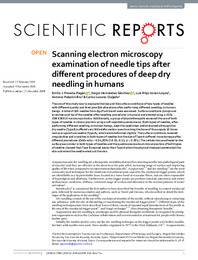Por favor, use este identificador para citar o enlazar este ítem:
https://hdl.handle.net/11000/34639Registro completo de metadatos
| Campo DC | Valor | Lengua/Idioma |
|---|---|---|
| dc.contributor.author | POVEDA-PAGÁN, EMILIO J. | - |
| dc.contributor.author | Sánchez-Hernández, Sergio | - |
| dc.contributor.author | Rhys-Jones-López, Luis | - |
| dc.contributor.author | Palazón-Bru, Antonio | - |
| dc.contributor.author | Lozano-Quijada, Carlos | - |
| dc.contributor.other | Departamentos de la UMH::Patología y Cirugía | es_ES |
| dc.contributor.other | Departamentos de la UMH::Medicina Clínica | es_ES |
| dc.date.accessioned | 2025-01-16T18:17:11Z | - |
| dc.date.available | 2025-01-16T18:17:11Z | - |
| dc.date.created | 2018-12-19 | - |
| dc.identifier.citation | Sci Rep. 2018 Dec 19;8(1):17966 | es_ES |
| dc.identifier.issn | 2045-2322 | - |
| dc.identifier.uri | https://hdl.handle.net/11000/34639 | - |
| dc.description.abstract | The aim of this study was to evaluate the tips and the surface conditions of two types of needles with different quality and their possible alterations after performing different needling on human beings. A total of 160 needles from AguPunt brand were examined. Surface conditions (lumps and scratches) and tip of the needles after needling procedures in humans were tested using a JEOL JSM-6360LV microscopy device. Additionally, a group of physiotherapists assessed the use of both types of needles in clinical practice using a self-reported questionnaire. Both types of needles, after performing different needling on human beings, kept the needle tips well preserved although the dry needle (Type B) suffered very little deformation even touching the bone of the scapula 10 times versus acupuncture needle (Type A), which were deformed slightly. The surface conditions revealed irregularities and scratches in both types of needles but the tips of Type A suffered more damage after different procedures (Odds ratio= 0.04,95% CI:0.01–0.13, p<0.001). The cellular tissue adhered to the surface was similar in both types of needles and the questionnaire about clinical practice of both types of needles showed that Type B seemed easier than Type A when the physical therapist penetrated the skin and when the needle went out the skin | es_ES |
| dc.format | application/pdf | es_ES |
| dc.format.extent | 10 | es_ES |
| dc.language.iso | eng | es_ES |
| dc.publisher | Nature Publishing Group | es_ES |
| dc.rights | info:eu-repo/semantics/openAccess | es_ES |
| dc.rights | Attribution-NonCommercial-NoDerivatives 4.0 Internacional | * |
| dc.rights.uri | http://creativecommons.org/licenses/by-nc-nd/4.0/ | * |
| dc.title | Scanning electron microscopy examination of needle tips after different procedures of deep dry needling in humans | es_ES |
| dc.type | info:eu-repo/semantics/article | es_ES |
| dc.relation.publisherversion | 10.1038/s41598-018-36417-w | es_ES |

Ver/Abrir:
Scanning electron microscopy examination of needle tips after....pdf
2,05 MB
Adobe PDF
Compartir:
 La licencia se describe como: Atribución-NonComercial-NoDerivada 4.0 Internacional.
La licencia se describe como: Atribución-NonComercial-NoDerivada 4.0 Internacional.
.png)